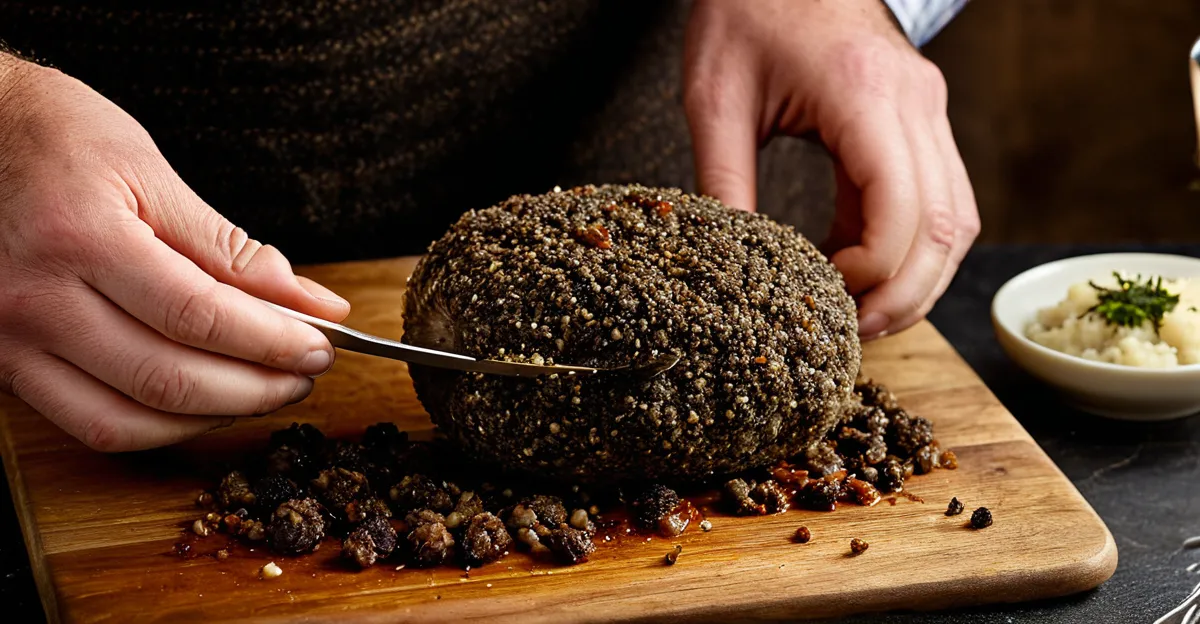Essential Ingredients and Their Roles
Authentic haggis ingredients are central to achieving the traditional Scottish food’s distinctive flavor and texture. The core components include key organ meats such as sheep’s heart, liver, and lungs. These provide richness and depth, fundamental to the authentic haggis experience. Alongside these meats, oatmeal serves as the vital grain, which absorbs the juices and binds the mixture.
Seasoning plays a critical role in elevating the dish. Black pepper, salt, and finely chopped onions contribute essential spice and aroma. The spice balance defines the hearty and robust flavor that makes traditional haggis beloved. Without proper seasoning, the haggis risks becoming bland or overly dense.
This might interest you : How Can You Incorporate Traditional UK Cooking Techniques into Modern Dishes?
For those unable to source certain organ meats, substitutions exist that aim to maintain authenticity. For example, finely minced beef heart can replace sheep’s heart, while pork lung might be an alternative to sheep’s lungs. However, careful consideration must be given to maintain the original texture and flavor profile, as these organ meats are irreplaceable in defining authentic haggis. In essence, the interplay of these ingredients—meats, grains, and spices—creates the soul of this iconic Scottish dish.
Step-by-Step Preparation Process
Mastering the details ensures authentic results
This might interest you : How do you master the art of making a classic English scone?
To excel in haggis preparation, start by handling the key organ meats—heart, liver, and lungs—with care. These should be thoroughly cleaned and finely minced or chopped to integrate smoothly with other ingredients. Ensuring the meat is fresh and trimmed of connective tissue maintains the ideal texture for authentic haggis.
Next, the haggis recipe steps call for toasting the oatmeal lightly. This step enhances the grain’s nuttiness, providing a complementary base to the rich organ meats. The oatmeal is then mixed with the minced meats, along with finely chopped onions and the traditional seasoning of salt and black pepper.
Combining these elements requires precision: add the spices carefully to balance robust flavor without overpowering the mixture. Avoid excessive moisture to prevent sogginess, maintaining a cohesive consistency.
Finally, the mixture is traditionally stuffed into a sheep’s stomach casing. Tying the casing securely is critical—this keeps the mixture intact during cooking. Alternative casings, like synthetic ones, can be used if natural stomach casing is unavailable but may alter texture slightly. This initial preparation phase sets the foundation for how to make haggis that reflects the cherished qualities of this traditional Scottish food.
Cooking Techniques for Maximum Flavor and Heartiness
Perfecting the art of cooking haggis
When cooking haggis, the traditional method involves gently boiling the stuffed casing in water for about 2 to 3 hours. This slow, consistent boiling ensures the haggis cooks evenly, allowing the traditional Scottish food to maintain its moisture and develop a tender texture. Avoid rapid boiling, which risks rupturing the casing and losing precious flavors.
For flavor tips, seasoning the water with bay leaves or herbs can subtly enhance the taste profile. After boiling, letting the haggis rest for 10 minutes helps the flavors meld and improves sliceability. To intensify the rich, meaty taste, some cooks opt for a brief rest period wrapped in foil or a warm cloth.
Achieving a hearty haggis preparation also means balancing moisture and texture. Overcooking can dry the dish, so timing is critical. Occasionally, chefs recommend piercing the casing gently with a toothpick at intervals to release excess steam and prevent bursting.
Ultimately, good cooking haggis practices result in a robust, savory dish emblematic of Scotland’s culinary heritage. These techniques safeguard both the dish’s characteristic flavor and fulfilling consistency.
Enhancing Taste and Texture
Subtle adjustments that elevate your haggis
To perfect haggis flavor, seasoning is key—beyond the traditional salt and black pepper, incorporating herbs like thyme or a pinch of cayenne can enrich the taste without overshadowing the organ meats. Carefully seasoning haggis during the mixing phase allows the spices to meld, creating layers of aroma and warmth that define this traditional Scottish food.
Adjusting the haggis texture is equally important. For a creamier consistency, some cooks add a splash of broth or a touch of butter into the mixture, balancing moisture without making the haggis soggy. Conversely, to achieve a firmer bite, lightly toasting the oatmeal beforehand enhances both nuttiness and grain structure, contributing to a heartier feel.
Variations on the classic recipe offer exciting options. Some introduce nuts or dried fruits for contrast, while others experiment with alternative grains like barley. These haggis variations preserve the dish’s essence yet bring subtle new dimensions, ensuring the dish stays engaging for modern palates.
Ultimately, balancing lean and hearty elements involves fine-tuning ingredient ratios and seasoning intensity. This approach allows you to customize the haggis to suit your taste while maintaining its authentic spirit and satisfying texture.
Serving Suggestions and Cultural Context
A taste steeped in Scottish heritage
When it comes to serving haggis, tradition plays a vital role. The classic accompaniments include neeps (mashed turnips) and tatties (mashed potatoes), both mild and creamy, balancing the rich, spiced organ meats. These staples provide a comforting contrast in texture and flavor, framing the traditional Scottish food perfectly.
Presentation varies by occasion. For Burns Night celebrations—a key event honoring poet Robert Burns—haggis is often served ceremoniously, piped in with fanfare and sliced with a knife while reciting poetry. This ritual emphasizes the cultural reverence of authentic haggis, showcasing its central role in Scottish identity. Casual meals might see haggis plated simply, highlighting its rustic appeal.
Sauces, such as a whisky or mustard cream sauce, complement the dish by adding smooth, tangy notes without overwhelming the robust flavors. These condiments enhance the hearty, savory experience expected from serving haggis.
Understanding the history behind haggis enriches its enjoyment. Originally a resourceful dish utilizing available ingredients, haggis symbolizes Scotland’s culinary ingenuity and cultural pride. Serving it with traditional sides and respect underscores its continuing importance as a symbol of Scottish traditions and hospitality.






